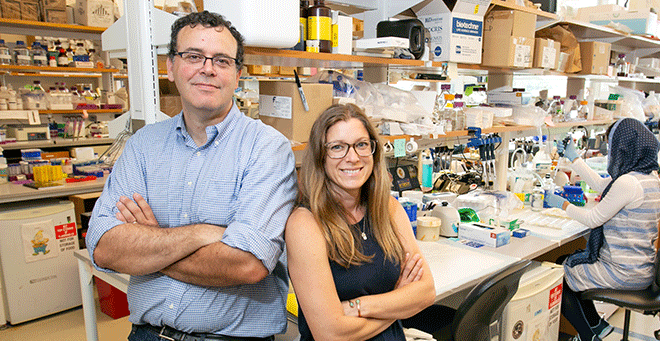Sio Gene Therapies, a clinical-stage company focused on developing gene therapies for neurodegenerative diseases, presented positive interim data from its ongoing Phase I/II study of AXO-AAV-GM1, an adeno-associated viral vector-based gene therapy candidate for the treatment of GM1 gangliosidosis.
Sio, formerly known as Axovant, licensed exclusive worldwide rights from UMass Chan Medical School in 2018 for the development and commercialization of gene therapy programs for GM1 gangliosidosis and GM2 gangliosidosis, including Tay-Sachs and Sandhoff diseases.
GM1 gangliosidosis is a progressive and fatal pediatric lysosomal storage disorder caused by mutations in the GLB1 gene that cause impaired production of the β-galactosidase enzyme. Currently, there are no FDA-approved treatment options for GM1 gangliosidosis.

Research into the causes and potential therapies for lysosomal storage diseases such as Tay-Sachs and Sandhoff diseases and GM1 gangliosidosis at UMass Chan Medical School and the Auburn University College of Veterinary Medicine has led to significant advances in the field, including development of the gene therapy vector used to deliver functioning copies of the defective genes that cause disease. Miguel Sena-Esteves, PhD, associate professor of neurology is a principal scientist of the research program at UMass Chan. Heather Gray-Edwards, DVM, PhD, assistant professor of radiology at UMass Chan is a part of the development team for the research discoveries, in conjunction with Douglas Martin, PhD, professor of anatomy, physiology and pharmacology at Auburn University College of Veterinary Medicine.
In a presentation at the European Society of Gene & Cell Therapy Virtual Congress in October, Sio described data from five patients in the low-dose cohort and the first patients in the high-dose cohort, which demonstrated an encouraging safety profile and a consistent dose response in disease biomarkers across the evaluation period.
“We are extremely proud of these data, representing our broadest dataset generated thus far, which support a dose response and a favorable safety and tolerability profile at both low and high doses,” said Gavin Corcoran, MD, chief R&D officer of Sio Gene Therapies. “We observed dose-dependent responses in two key biomarkers, including normalization of both biomarkers in the high-dose cohort. Taken together, six out of seven patients show no evidence of overt disease progression at the latest time point assessed, and we now have a better understanding of the clinical measures that may serve as important indicators of efficacy.
“Based on the results of this ongoing study, we are working on the continued development of AXO-AAV-GM1 and plan to engage the FDA to discuss further development, recognizing that there is currently no approved therapy available for GM1 patients.”
Cynthia Tifft, MD, PhD, deputy clinical director of the National Human Genome Research Institute and study principal investigator added, “I have dedicated my career to the care of patients with GM1 gangliosidosis and to research efforts in the search for a functional cure. The biomarker dose response and favorable safety profile is a remarkable finding for the gene therapy field. I am excited about the potential impact that AXO-AAV-GM1 may have on the lives of these children and their families. I look forward to seeing the longer-term data, where we may have a chance to see not only durable disease stabilization, but possibly even improvement.”
Data presented at the conference showed a dose-dependent improvement in key biomarkers of disease activity: β-galactosidase enzyme activity in the serum and GM1 ganglioside activity in the cerebrospinal fluid; serum β-galactosidase activity achieved a normal range in both patients in the high-dose cohort at six months; all five patients in the low-dose cohort saw an increase in the same timeframe.
There was no clinical evidence of overt disease progression in four of five low-dose patients at 12 months and both high-dose patients at six months as assessed by measures of development including the Vineland-3 Adaptive Behavior and Upright and Floor Mobility scales.
Longer-term evaluation of eight patients in the low- and high-dose cohort is ongoing; two patients have received the low dose of AXO-AAV-GM1, and screening for enrollment of patients in the high dose cohort is ongoing.
AXO-AAV-GM1 delivers a functional copy of the GLB1 gene via an adeno-associated viral (AAV) vector, with the goal of restoring β-galactosidase enzyme activity for the treatment of GM1 gangliosidosis. The gene therapy is delivered intravenously, which has the potential to achieve a broad central and peripheral biodistribution. Preclinical studies in murine and a naturally-occurring feline model of GM1 gangliosidosis have supported AXO-AAV-GM1’s ability to increase β-galactosidase enzyme activity, reduce GM1 ganglioside accumulation, improve neuromuscular function and extend survival.
Related stories on UMassMed News:
USA Today reports on first baby in gene therapy clinical trial for Sandhoff, Tay-Sachs diseases
First patient dosed in clinical trial of gene therapy for Tay-Sachs and Sandhoff diseases